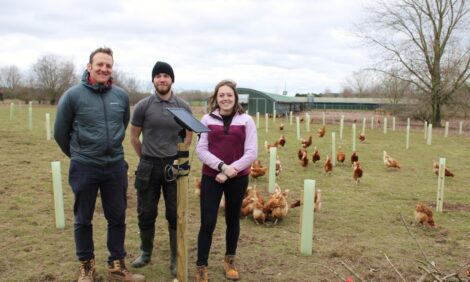



Earth BioGenome Project: Solutions for the future of agriculture?
The US Department of Agriculture (USDA) is partnering in the Earth BioGenome Project (EBP), biology's version of the moonshot, an effort that will yield millions of powerful new solutions to agriculture's challenges EBP is an international cooperative initiative to sequence during the next 10 years the DNA of more than 1.5 million species – those more complex than bacteria – representing the world's biodiversity. The initiative was highlighted in a recent Proceedings of the National Academy of Sciences article.
EBP is an international cooperative initiative to sequence during the next 10 years the DNA of more than 1.5 million species – those more complex than bacteria – representing the world's biodiversity. The initiative was highlighted in a recent Proceedings of the National Academy of Sciences article.
EBP calls for scientists to sequence the genomes of 9,330 species, one from each plant, animal and protozoan taxonomic family as reference genomes in the first three years. Then, the plan calls for sequencing the genome of one species from each genus – the next taxonomic division finer than family – during years four to seven, although in less detail, for a total of about 150,000 genera. The remaining 1.5 million species would be sequenced in still less detail during the final four years of the project.
"The benefits that will come from increasing our knowledge and understanding of the genomes of the Earth's biodiversity will be monumental, especially for agriculture," explained Kevin Hackett, senior national programme leader for entomology with USDA's Agricultural Research Service (ARS). Hackett is one of only three federal members on the 23-person EBP steering committee and he is representing agriculture.
As an example of the importance to agriculture, Hackett pointed out that insects destroy one-fifth of the world's crop production annually and would do worse without pesticides. Control of insect devastation is an ongoing struggle, and pesticide resistance is an ever-evolving problem, requiring researchers to look constantly for new ways to tackle the issue.
"Understanding a pest's DNA and biology is essential to precisely targeting new controls, to combatting an insect without harming other species or other pieces of the ecology," Hackett said. "There are solutions to problems in pest control out there in the genetic biodiversity that we can barely conceive of right now."
For instance, who could have guessed that a jellyfish's DNA would have provided a glowing green fluorescent protein that lets scientists trace when compounds too small to be seen by microscopes are being made in the cells of species as diverse as peas and pigs?
Genomic information is already providing the basis for other powerful advances from speeding up breeding for enhanced plant and animal traits to helping increase safety from ticks and diseases associated with them.
For example, ARS insect physiologist Felix Guerrero and his team recently sequenced the cattle fever tick genome and identified genes now being used to develop a vaccine against the ticks. This vaccine may protect cattle from several fatal tickborne diseases and eventually fight other ticks including those that spread Lyme disease to people.
Another ongoing ARS-led project is Cornome, which is planning to completely sequence ten of the most important agricultural insects in corn, so that when RNA interference (RNAi) gene silencing is applied to create a new pest control, scientists can first check the DNA of non-target insects to make sure they would not be harmed by this new technology.
EBP is not beginning its massive task from scratch. It is building on already-existing efforts to sequence the genomes of more specific taxonomic groups such as the Global Invertebrate Genomics Alliance (GIGA), which is targeting 7,000 non-insect/non-nematode species with an emphasis on marine taxa, and the i5K Initiative, which is sequencing the genomes of no less than 5,000 arthropod species important to agriculture and biological research. Hackett is an i5K co-founder and one of its co-chairs.
So far, scientists from around the world, individually and in various networks, have sequenced the genomes of about 15,000 species, less than 0.1 percent of all life on Earth.
The total cost for phase I of EBP is estimated at about $500 million. The total cost of the 10-year project is expected to be roughly $4.5 billion. EBP's feasibility benefits from the sharp decline in sequencing costs, down from $10,000 per genome in 2001 to $1,000 today.
EBP expects most of the funding to be donated by foundations. For more information about ARS genomics and i5K work, please see Unravelling What Genomics Can Do
As reported by EBP










